SCOUTED: The Striker Factories
SCOUTED uses SkillCorner data to analyse three clubs that have seen notable success in identifying and developing young strikers
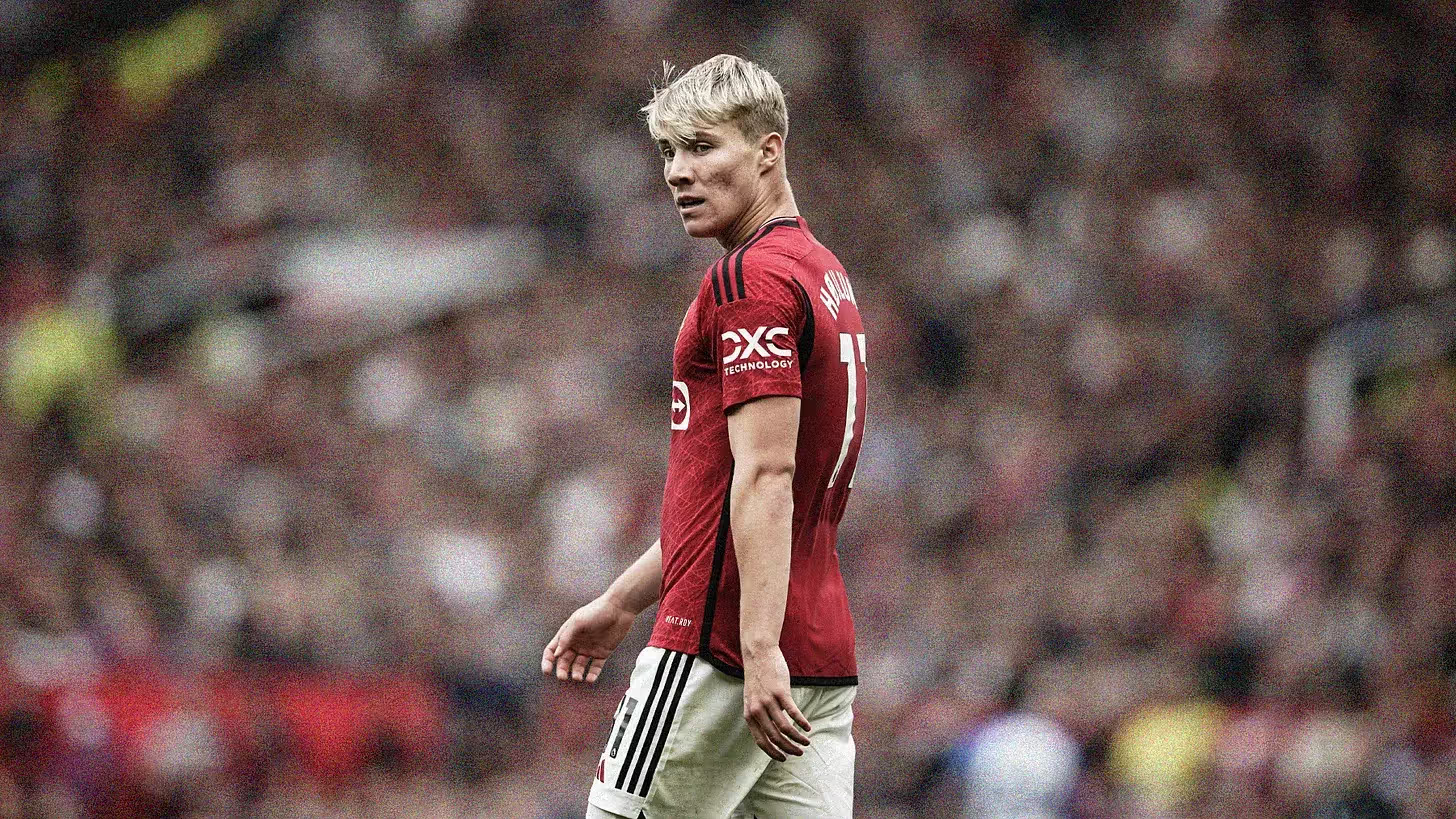
SkillCorner has partnered with Scouted Football, providing data and insights to support their writing on the best emerging talent in football. In this article, the Scouted team used Physical and Game Intelligence data to analyse three clubs that have had notable success in developing young strikers, and how it has driven success on and off the pitch.
There is no market more volatile than the striker market. An outlier month or two can propel a striker from relative anonymity to hot property. Today, clubs are willing to make a big investment based on a relatively small sample size: see Rasmus Højlund.
So, for clubs outside Europe’s top five leagues looking to consistently turn a profit, few avenues are more lucrative than hand-crafting strikers. And that profit, reinvested properly, can turbocharge an ascent through the divisions and provide the financial muscle to compete on the domestic front.
Take Austria’s Sturm Graz, for example. Sturm Graz ended Red Bull Salzburg’s near-decade run of Austrian Bundesliga titles this season, after a sequence of striker sales: Kelvin Yeboah (€6.5 million), Emanuel Emegha (€13 million), and of course, Rasmus Højlund (€20 million). They followed those sales with the January loan — and now permanent acquisition - of Arsenal’s Mika Biereth, who played a key role in the back half of last season’s title win.
It’s interesting to see this snowball in real time. The first domino: Sturm Graz sold Yeboah for €6.5 million, when their previous record sale was €3 million. Then, after spending no more than €1.5 million on signings in a single season since the early 2000s, the club’s transfer expenditure increased from €1.2 million to €2.4 million, which brought Højlund to the club. Højlund’s sale increased their expenditure the next season to just over €7 million, which brought Emegha to the club. And then Emegha’s sale has maintained expenditures at almost €6 million last season, and now around €7.5 million already in 2024/25 (including the permanent acquisition of Biereth).
It’s important to contextualise these fees for a club of this size. Before the 2021/22 season, Sturm Graz’s operating revenues had never eclipsed the €20 million fee they received for Rasmus Højlund.
This influx of cash has not only allowed the club to expand its operations in the transfer market, but also explore the renovation of their home stadium, the Merkur-Arena, to bring it up to UEFA category one standard.
Sturm Graz are a beautiful example of a club playing its cards right, and snowballing each move into the next. It’s a brilliant, concentrated, buy-low, sell-high scheme, aimed at developing the most financially valuable players in the sport: strikers.
It sounds simple, but dig a little deeper and you’ll find a club-wide system specifically designed to build valuable number nines. Like any great factory, Sturm Graz have fine-tuned every step of the process to ensure quality in the final product. What comes off the assembly line is a perfect, trademarked specimen.
Here’s how they do it...
What are the elements of a great striker factory?
Is it all recruitment? Internal development? Playing style? A combination of all the above?
Let’s assess Sturm Graz alongside two other clubs with success in flipping strikers in recent years: KAA Gent (Jonathan David, Roman Yaremchuk, Gift Orban) and Partizan Belgrade (Dušan Vlahović, Umar Sadiq, Matheus Saldanha).
Is there a replicable model across these three clubs? Or do Sturm Graz do something different?
Let’s do some digging.
The first interesting point here is Sturm Graz’s stability in coaching. Christian Ilzer has been at the club since this cycle began in 2020, and has brought through all of their big-money strikers. On the flipside, Gent and Partizan have both had quite a bit of turnover, with five and seven different managers in the same time period (though Gent did have the same manager, Hein Vanhaezebrouck, from December 2020 until June 2024).
You'd have to imagine the stability at Sturm Graz is critically important, but let’s unpack some SkillCorner data and see what it tells us about these three clubs and their approaches to squeezing big goal hauls from their number nines.
Sturm Graz: the athletic system
With Rasmus Højlund and Emanuel Emegha, it was pretty obvious Sturm Graz were identifying a type: hyper-athletic strikers who can blow games open with their speed and work rate.
Mika Biereth is more of an industrious type, but he still shows good signs of growing into this mould. Here’s all three of these strikers physical numbers compared to other Austrian Bundesliga strikers over the last three seasons.

If we look a little more closely into Sprinting Distance and PSV-99 (99th percentile of peak speed velocity), we can see an array of Sturm Graz players making up the top 40 (of 71 datapoints) strikers over the last three seasons in the Austrian Bundesliga. Here’s Sprinting Distance:
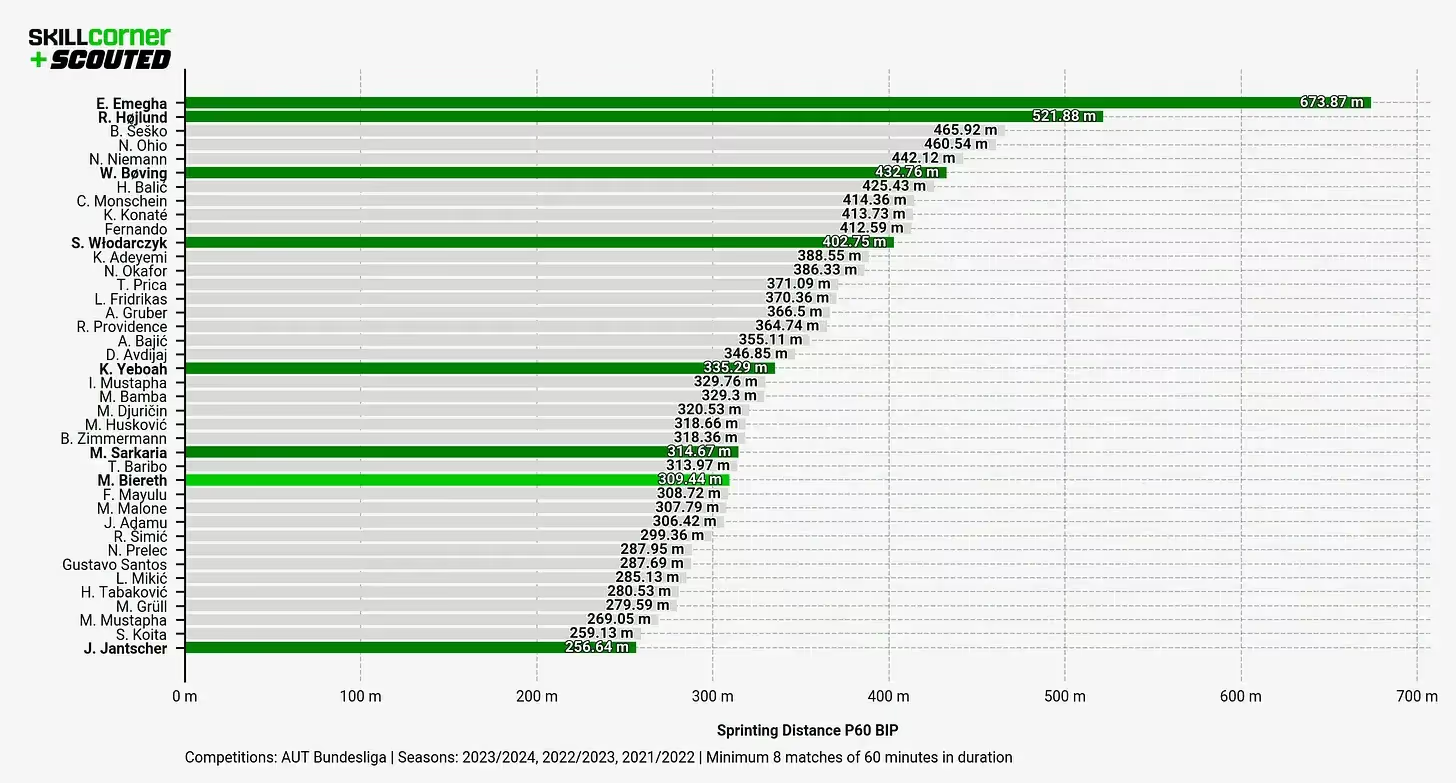
And here’s PSV-99:
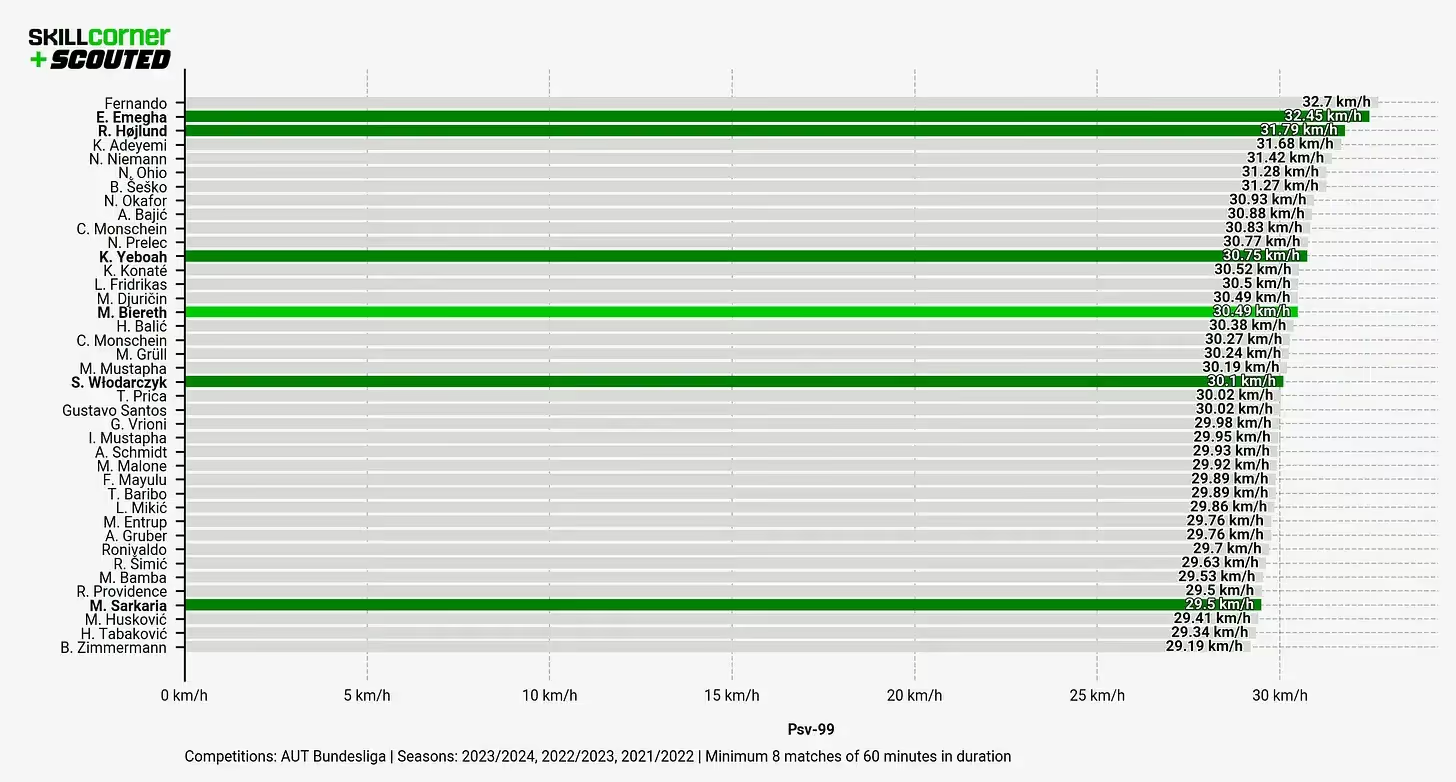
Yeboah, Højlund, Emegha, Biereth… all the usual Sturm Graz suspects chart well, but there are a range of other bit-part pieces here who are also performing strongly.
This suggests to me not only are Sturm Graz trying to recruit good athletic forwards, but their play style specifically leans into this type of player.
To confirm this suspicion, let’s look at possession stats first. Sturm Graz have finished first, second and second in the last three seasons, so you would expect, as the strongest team in the league outside of the Red Bull juggernaut, they’d keep the ball quite a lot.
But they don’t. In all three seasons they’ve averaged between 49% and 51% of possession. They clearly play a more direct style than expected for a conventionally good team in their league.
Another interesting way of showing you their aggressive nature is by looking at Dangerous Pass Attempts Under Pressure per 30 TIP compared to other clubs over the last three Austrian Bundesliga seasons.
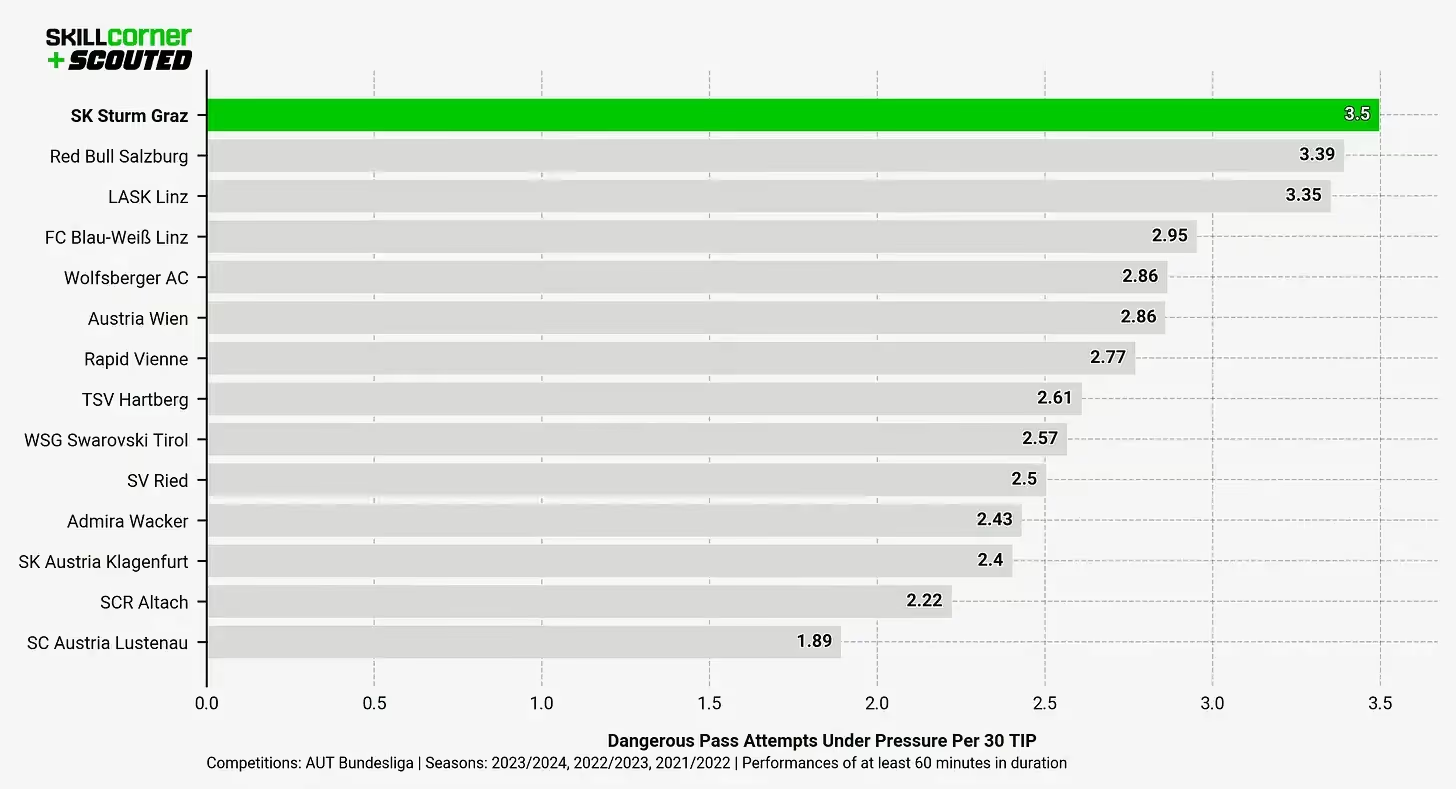
And one last metric to hammer things home - Difficult Pass Attempts Under Pressure per 30 TIP:

They attempt to move the ball into dangerous areas more often than anyone else, they try to pick off difficult passes the second most; this is a team that plays up-and-down football. All of this centres around getting the ball into the final third quickly and empowering the attacking players, giving them the ball in as much space as possible.
I think it’s important to wrap our heads around the idea some strikers don’t just score more goals because they are better than their peers. Team style is massively important. Christopher Ilzer has established an identity and structure that puts strikers on a pedestal and helps Sturm Graz maximise their value. In turn, after each big sale, he gets a replacement plus reinforcements for other positions before the cycle is repeated.
Obviously, team quality is also crucial. A great juxtaposition with Sturm Graz is Salzburg, the Red Bull goliath who, in the same league, boast their own immense striker factory.
Salzburg were in a similar boat to Sturm Graz many years ago - they moved the ball quickly to intentionally allow their strikers to feast - but are now so financially dominant they can play whatever system they like and still score a bucketload of goals. They’ve averaged 2.61 (!!!) goals per game in the league over the past six seasons.
That, naturally, has facilitated the monster sales of Patson Daka, Karim Adeyemi, Erling Haaland and Benjamin Šeško, with more on the way: Roko Šimić, Karim Konaté, Petar Ratkov, and Adam Daghim are all on the factory floor.
Controlled Environment: the league effect
Many readers will acutely understand this already, but league style and standard is fundamentally important to a player’s development. I find the very simple goals per game metric to be illuminating, here.
Here are Europe’s top eight leagues, plus Austria and Serbia for goals per game, over the last three seasons:
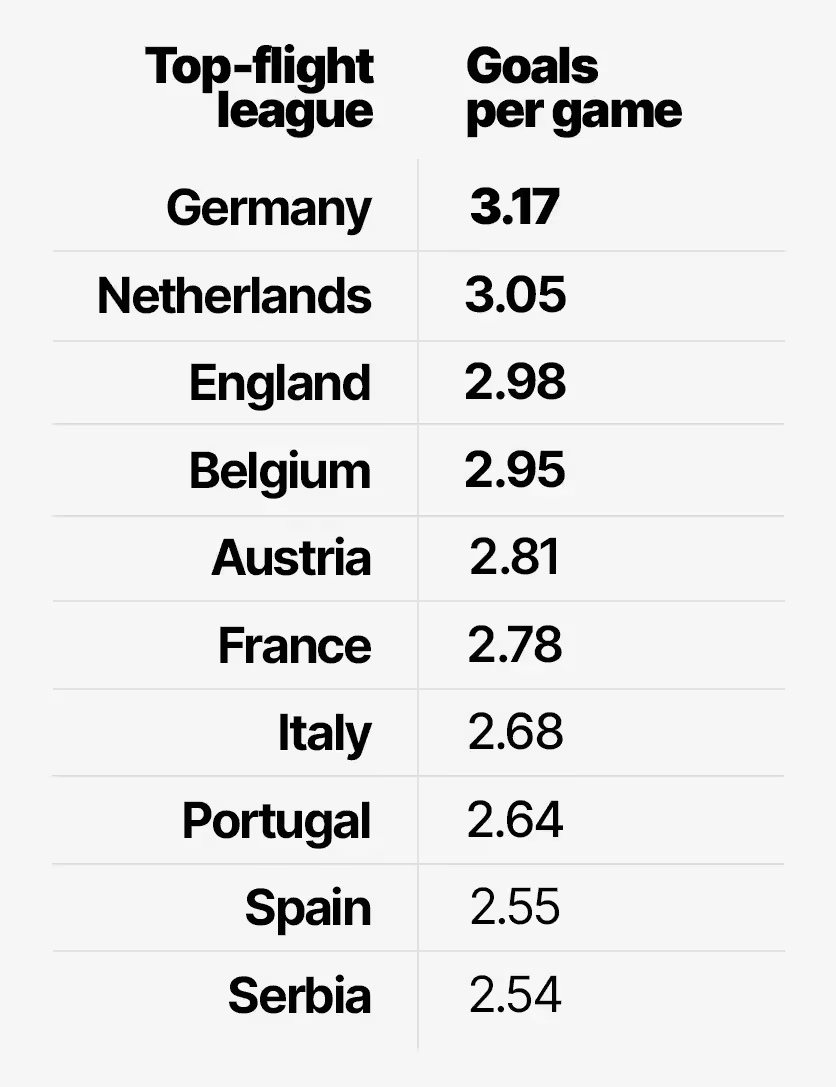
The differences might not seem significant, but the gap between England and Spain on the graph above produces 490 goals across three seasons, or 163.3 goals per season. Let’s just say this can help…improve…the stats of attacking players in some leagues over others.
It’s an idea I have introduced in the past, particularly in this piece on leagues in the AFC, in which South Korea’s K-League often averages around the 2.5 goals per game number.
In that piece (which I’d recommend reading because I think a lot of its ideas can be extrapolated to smaller leagues in Europe) I reach the conclusion that the lack of goals in K-League is largely influenced by the passivity and lack of directness of Korean teams in possession.
In contrast, the European standout is the Netherlands, a league which has averaged 3.05 goals per game over the last three seasons. More than one club has leveraged this stylistic foundation into big-money sales of attacking players.
So, is this the secret? Simply existing in a league that features a ton of goals?
I think a few Portuguese clubs would argue against such a simple conclusion, but there’s no doubt it helps. Especially if you’re a sub-elite team below the stature of Porto, Benfica or Sporting, who are regularly playing Champions League football and have decades-long proven track records of developing top level players.
I mentioned two such teams above. Now let’s go a little deeper on those, to see how striker factories are built beyond Austria.
Partizan Belgrade: the support system
Partizan Belgrade may not be as prolific as Sturm Graz at turning strikers into profit, but considering their circumstances, are an interesting case study nonetheless.
While a much more established domestic competitor than Sturm Graz, Partizan have recently played second fiddle in Serbia to Crvena Zvezda, and have failed to win the league since 2016/17.
Crvena Zvezda have become Partizan’s version of Red Bull Salzburg. Their revenues dwarfed Partizan’s by a factor of four in 2022/23 (€57.6 million to €13.8 million). European football revenues are crucial to the economic health of Serbia’s big two, but Partizan have not been as successful on the continent as their cross-town rivals. A three-year European ban in 2017 certainly hasn’t helped the cause.
But one sale, and another potential one, have piqued my interest as Partizan look to turbocharge their recovery.
The first was the sale of Umar Sadiq to Almeria for €9 million in 2022. Now, Partizan are rearing Matheus Saldanha for market, whom they picked up from Japan’s J2 League just 12 months ago.
Saldanha has been a revelation for Partizan, scoring 18 goals in around 1,800 minutes in the league since his arrival, with four assists and five (!!!) penalties won.
Is there something in the water, then, or is this one-two punch a result of good fortune and smart recruitment? There are arguments for both, but let’s dig into what the SkillCorner numbers tell us.
Here are Matheus Saldanha’s running numbers from 2023/24, compared to other strikers in the Serbian Superliga:
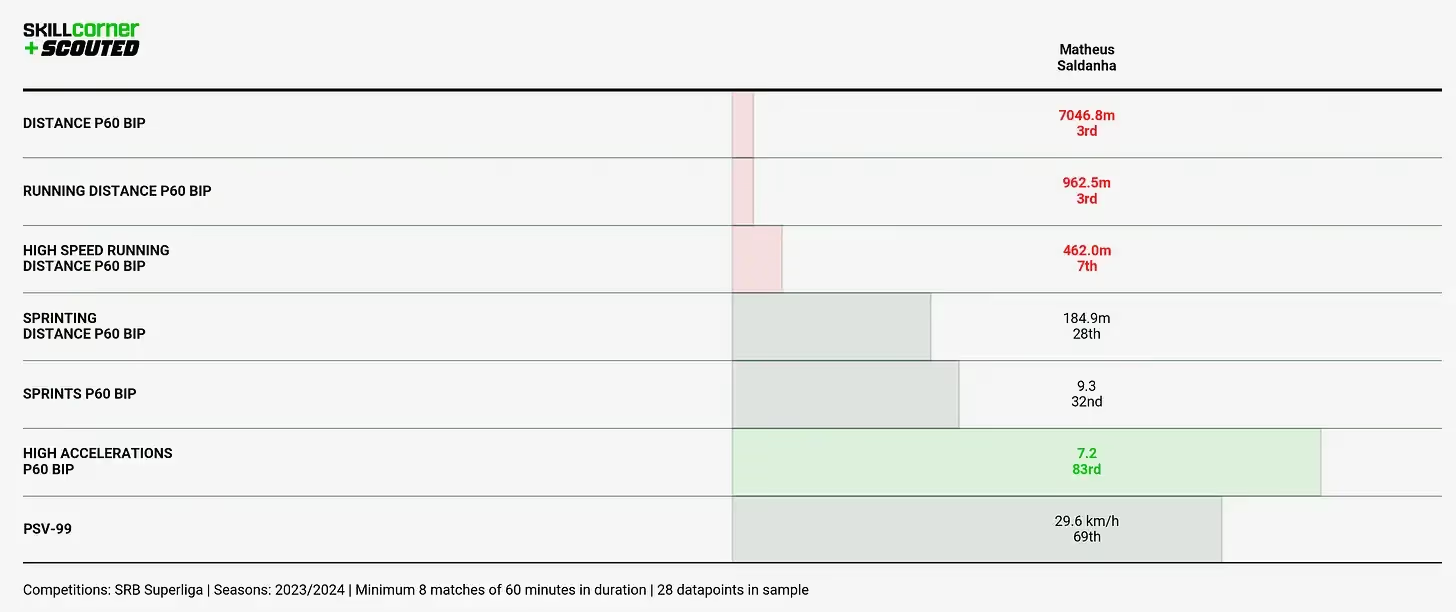
You’ll notice straight away these numbers are very different from the Sturm Graz archetype. It should be stressed they aren’t necessarily bad, but certainly different. As such, Partizan play differently to the Austrian side; but in a way that similarly platforms their centre-forward.
Instead of the striker being the leading provider of verticality, Partizan use their wingers: Aldo Kalalu and Xander Severina.
The statistical profile of the team reminded me a little bit of Atalanta, who I wrote about a couple of months back. For Gian Piero Gasperini, the wingers run in behind and stretch the opposition, while the strikers and midfielders cash in as support runners.
Here are Partizan’s wingers compared to others in the Serbian Superliga:
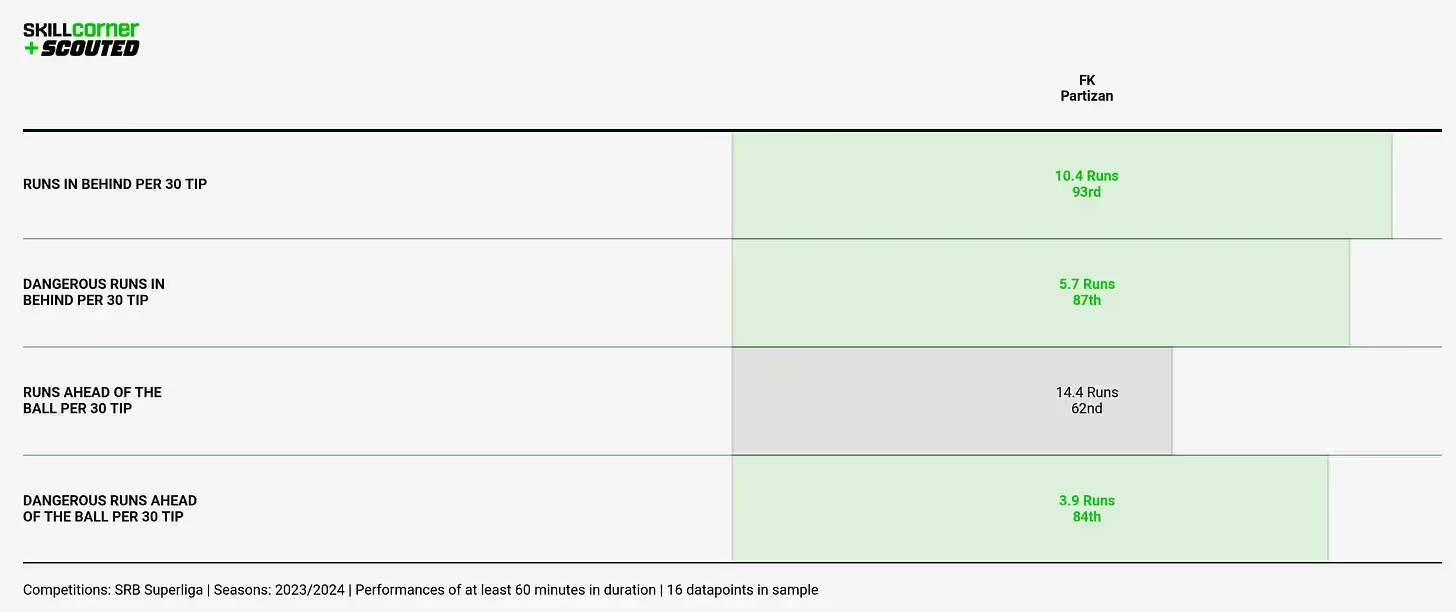
And here are Matheus Saldanha’s support run numbers:
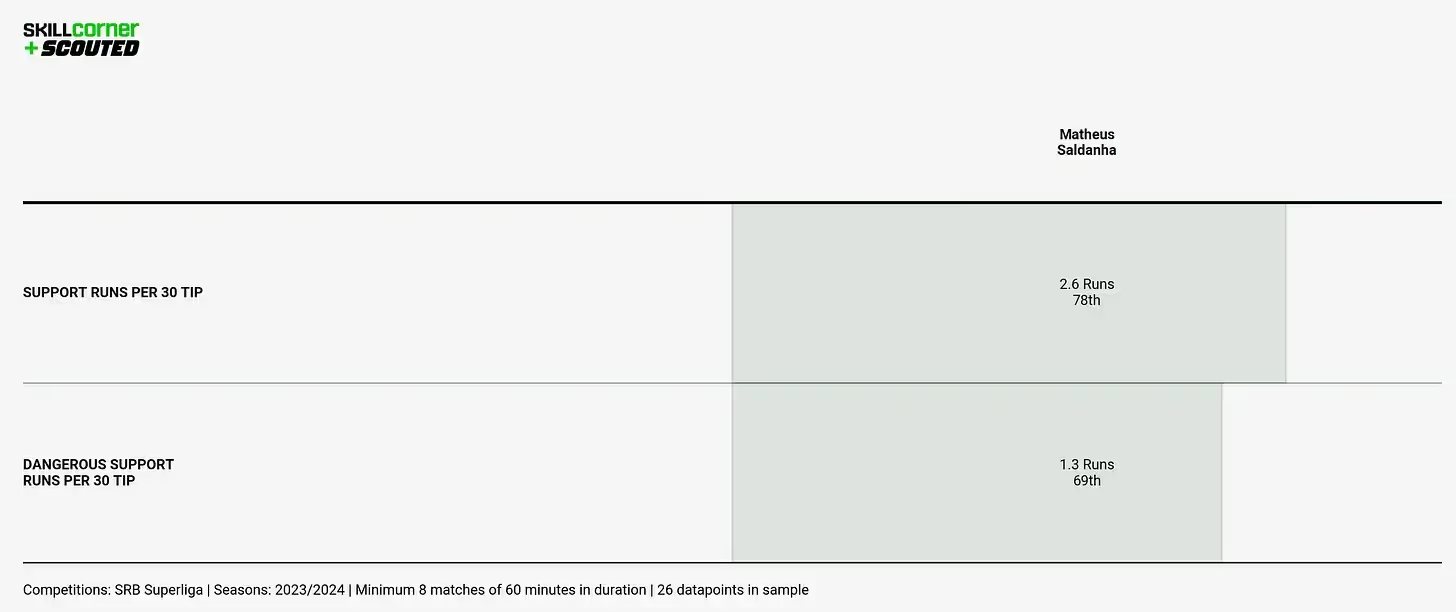
I don’t think this is quite as effective at funnelling play to the strikers as Sturm Graz’s method, because it places a lot of emphasis on midfielders pushing forward to attack the box.
This system bagged Bibras Natcho 11 goals in the league last season, and Partizan midfielders make more Dangerous Runs per 30 TIP than any other team in the Serbian Superliga.

But there are many ways to skin a cat. I’ve watched tape of Saldanha, and it’s obvious why Partizan have chosen to use him this way. He is a very dribbly, technical, and creative (I won’t get into some of his passing numbers, but they are really good) number nine, who creates his own shots. Partizan ask him to get on the ball, be aggressive and take risks, and he pays them back in goals and assists (plus, again, five penalties won since his arrival). It’s a good deal.
I also think this kind of player is more effective in a lower scoring league than the out-and-out athletic type Sturm Graz develop. There’s less space to run into behind opponents, and the defensive systems are more rigid.
To illustrate this, the Serbian Super League averaged 2.54 goals per game last season, compared to the Austrian Bundesliga’s 2.81, while their players on average received 0.37 Passes to Dangerous Runs in Behind compared to 0.46 for players in the Austrian Bundesliga. That comparison becomes even more stark when looking at strikers (1.14 compared to 1.7).
The only lasting question I have was whether this was all intentional, or whether the recruitment team stumbled onto a gem that suited the system perfectly. If Partizan do sell Saldanha this summer, we’ll have to track how they fare in choosing his replacement.
KAA Gent: the recruitment system
Who can forget Gift Orban’s generational Conference League run in 2023? In the 22/23 knockouts and 23/24 group stage, Orban scored 10 goals in 831 minutes, turning himself from a €4 million signing into a €14 million sale for Gent in the space of 12 months.
This run came after some pretty productive seasons in the proceeding years from Jonathan David (18 goals in 2,100 minutes in his final Belgian Pro league season), and Roman Yaremchuk.
What immediately struck me without even looking at the detailed statistical profiles is these are three immensely different footballers. Yaremchuk is a tall, connecting forward. David is a mobile, movement-oriented player. Orban is a speed demon.
The club don’t seem to target a distinct profile but have great success nonetheless, collecting more than €50 million in profit from these three players alone since David’s sale in 2020. That’s almost an entire year’s operating revenues.
To answer the question before I even pose it, it’s definitely possible to recruit really good strikers and turn them into money-spinners without committing to playing a single way. One might even argue doing so without a long-term coach or club-wide strategy is the optimal approach: simply recruit the best talent you can and work around it.
Glancing at some Physical and Off-Ball Running stats from SkillCorner, I can confirm the above three are very different strikers.
Here are the physical comparisons, compared to strikers in the Belgian Pro League across the last five seasons:

And here are the Off-Ball Runs:
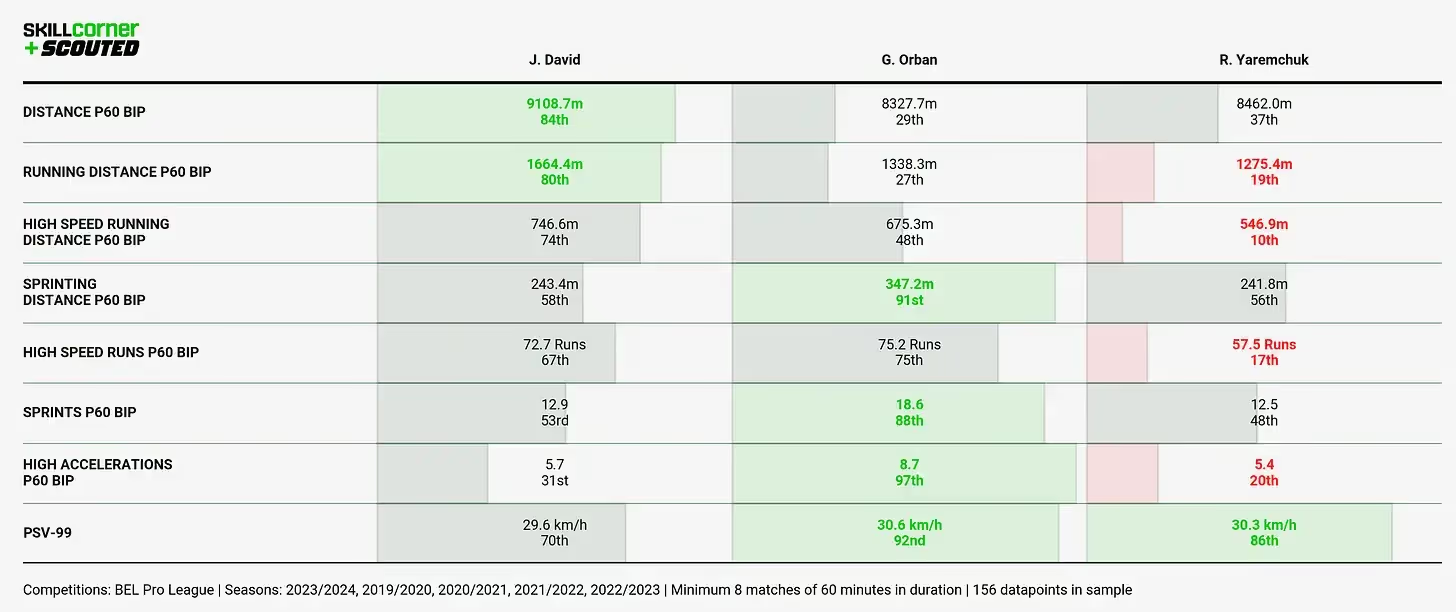
As you can see, Gift Orban is a running in-behind machine. These are incredibly valuable runs and get strikers into great positions to score. His style is very much the ‘Sturm Graz’ style.
Not only was this amazingly successful in the Conference League, but he also scored 18 goals in about 2,000 league minutes during his year with Gent — serious numbers.
On the flipside, you can see how Yaremchuk was more of an offensive fulcrum, with lots of support runs and less cross-receiver runs than you would expect for a guy who’s around 6’4”.
David was a hive of activity, doing bits and pieces of everything in his own unique style that is very malleable to whatever his team needs, minus the outright explosiveness of Orban.
Evidently, these players were all exceptionally good in the Belgian Pro League. While Gent don't follow the conventional set-up of Sturm Graz in choosing a profile of forward and building around it, they are able to identify cheap talent with outlier qualities to bang in goals regardless.
While this throws a bit of a curveball to the club’s recruitment team, it also allows them to broaden their search for players without the strict confines of targeting a specific profile of number nine.
The Pro League is typically quite a high-scoring league too, which is, as discussed, an advantage for Gent’s attacking players.
Which factory is best?
While these three clubs have all made things work, you can probably guess from the general flow of this piece I think Sturm Graz has the best model for striker factories.
All three have their merits. Gent are a more financially powerful club that can acquire better raw talent, so are naturally more flexible in who they approach.
Partizan are in the early stages of developing something, but what they’ve found in Matheus Saldanha will become especially interesting when they try to replace him. All-action offensive hubs with free reign to do anything and the talent to do everything are not easy to find.
So, Sturm Graz’s model is the most repeatable.
It is structured and has clear motives and intent, all pointing towards feeding the beast up top. It doesn't rely on outlier technical qualities, just high level athletic ability — an easy trait to identify when it comes to finding replacements. While it obviously doesn't hurt, this system isn't reliant on finding players as talented as Rasmus Højlund. They know exactly what they’re looking for and have proven they can consistently find it.
That might just be the secret to a great striker factory.
How to buy a striker?
With all this learning in hand, let’s turn our focus to its application in the market. How can clubs, technical directors and recruitment staff apply this knowledge to identify their own low-cost, high-potential strikers?
There are several interesting angles from which to approach this question.
I think an overarching takeaway from this piece is that an average player can look amazing in the right system; consequently, an amazing player can look average in the wrong system.
Having a tactical style and matching processes at your club which make the kind of striker you’re looking for obvious is just as important as identifying best-in-class talent. This is why the Sturm Graz system has been so fruitful.

Ultimately, I don’t think finding a number nine (outside of the uber-elite level) is any more difficult than finding players in other positions. But often clubs don’t know what they want/need, or have unrealistic expectations. In an inflated market, this can lead to severe misallocations of resources towards players who don’t match the buyer’s tactical styles.
On the other end of the spectrum are players like Roberto Firmino. The Brazilian wasn’t rated at Liverpool because he was prolific (he only scored more than 12 goals in one Premier League season) but because he was a perfect, complimentary fit between Sadio Mané and Mohamed Salah. He fit the system.
The question here is whether players like Firmino are value propositions for smaller clubs, given their role functions as a complimentary, facilitating piece rather than a focal point. This ultimately limits their ability to put up massive goal contribution numbers that tend to attract big-money moves.
It’s also probably true that clubs without the resources of Liverpool are more likely to play a direct, transitional style through their number nine, rather than elite wide players like Salah or Mané. And there is no shortage of players that fit the bill.
There are other clubs that are not far behind Sturm Graz in keeping a close eye on this space. Searching up random, young, high-PSV-99-ranking strikers in Denmark, the two fastest, Ibrahim Osman and Mohammed Fuseini, have moved to Brighton and Union St. Gilloise (via Sturm Graz) respectively; the third, Orri Óskarsson, will likely be one of FC Copenhagen’s next big sales (he is currently very strongly linked with both Real Sociedad and Manchester City).
For Union St. Gilloise, Fuseini is replacing Mohamed Amoura, an equally rapid striker who was signed for €4 million from Lugano in Switzerland last year, and flipped to Wolfsburg this summer for a fee approaching €20 million.
Clubs are taking this approach seriously, with high-end athletic attributes increasingly coveted in young strikers, and young players more widely. Some clubs have identified this, and are making it a focus of their operations. With tracking data like SkillCorner’s, identifying these players is not difficult. After that, it’s all about timing the market, providing the right environment and tactical style to ensure these players flourish, and ensuring you have a succession plan in place to continue cycling the process.
Written by Steven Ganavas.
Click here for more information on our football products.
Click here for more of Scouted's writing on emerging football talent.

